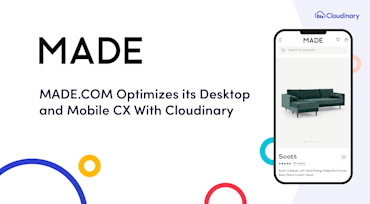Using a company’s software in-house was made famous by Microsoft’s adoption of the term “eating our own dog food” to refer to the request to employees to use the alpha and beta versions of their products. This story, “Drinking Our Own Champagne” refers to our serving videos created by our Customer Training team with the Cloudinary Video Player to implement a business initiative and enhance site performance.

While managing marketing campaigns, you’ve most likely come across situations whereby a campaign must go live ASAP. Or, last-minute changes in the content, design, or brand guidelines emerge just before launch. In those circumstances, getting your creative team to generate new images or modify existing ones on a tear can lead to a lot of stress and missed deadlines. To help you navigate those rough waters, we are releasing an integration of Cloudinary with the Salesforce Marketing Cloud (SFMC) content builder.

Part 1 of MythBusters busted the myth of unstable tests. Part 2 here smashes another myth: “UI tests are slow.” Far be it from me to dispute that UI tests are slower than unit or integration tests, but let me show you the best practices that speed up UI tests.

A true digital-native business, everything that London-headquartered MADE.COM does is shaped by its belief that great design should be available to everyone—a brand promise it fulfills by offering high-quality, exclusive home furnishings, and beautiful furniture. As the UK’s first online only furniture retailer, MADE is constantly improving the virtual customer journey through engaging visual experiences. As Edmund Kleiser, head of technology operations, states, “Strong and compelling imagery is everything to us to help us engage our audience.” Shoppers love to see ultra-high quality images of MADE’s 6,000 sofas, storage solutions, and floor lamps in exquisite, sharp detail. Huge care goes into defining the quality and aesthetic of product pictures, including the choice to deliberately limit the color palette.

tl;dr;
Cloudinary conducted a workshop at React Summit 2021 to highlight the effect of media performance on websites by correlating it with Google’s Core Web Vitals and other performance measurements. Also presented were typical optimization techniques along with code samples. Here are the recording and the slides.

Recently, Cloudinary’s Digital Asset Management (DAM) solution was named a leader of the top 15 global vendors in the DAM Vendor Selection Matrix™ produced by Research in Action GmbH, excelling in strategy, execution, price versus value, and breadth. The matrix also awarded Cloudinary an outstanding recommendation index of 98%.

Since its founding Cloudinary has been a people-driven business. We wanted to create a culture fueled by transparency, trust and collaboration to encourage our employees to always be developing, learning and contributing.

Optimized media assets have always been essential to website performance. To help developers measure, understand and improve website performance, Google created Core Web Vitals, a subset of Web Vitals that focuses on three aspects of the user experience: loading, interactivity, and visual stability. In June 2021, Google plans to make page experience a ranking factor—so Core Web Vitals and media asset optimization will become even more important.

Setting up the infrastructure for video uploads can go from straightforward to complex real fast. Why? Because many challenges are involved in building a foolproof service for an efficient and smooth process.

For years, Google has been updating its search algorithm to prioritize end-user experience, displaying the most relevant and helpful content at the top of search results. The latest—and maybe the most significant—update so far is Core Web Vitals (CWVs), which are new metrics announced a year ago that will, starting in June, begin determining search rankings. With this update, Google is being abundantly clear that visual experience of webpages is paramount.
